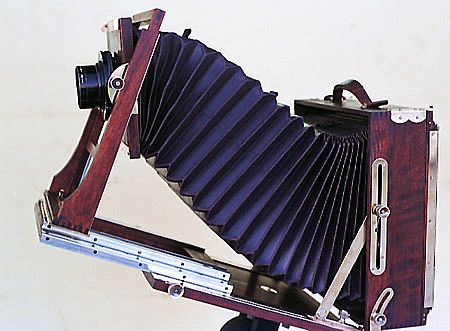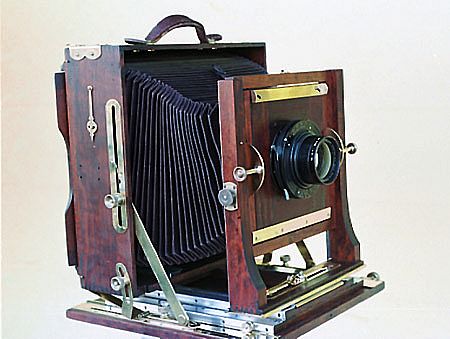
by Sean Yates for the
Large Format Page
with photographs from Midwest Photo Exchange and Dick Streff

The Century Universal is an infrequently encountered but interesting and usable camera manufactured in the thirties. While it is not as robust as an Ansco or Deardorff, it is lighter than both, more flexible than the Kodak 2D and often can be had at reasonable cost..
In the 3 years I’ve been on-line I’ve seen at least half a dozen auctioned on Ebay and 3 "in the flesh" at camera shows and older retail stores in Chicago, not to mention several in various classified adds. In good condition with new bellows they seem to hover around $500.00 — although I have seen them advertised by New York City retailers as high as 750.00. I imagine it is hard to come by because of its relative fragility and because there weren’t that many made to begin with. The first one I saw was very worn and the bellows were a total loss, but what immediately struck me was how light it was. At the time I owned a 5 X 7 Wisner Technical Field, and I swear the Century weighed less. This was an 8 X 10 worth investigating!

The Century Camera company started in 1900 (hence the name). George Eastman got controlling interest, and eventually Eastman Kodak absorbed Century, as it had so many other photographic concerns in and around Rochester. Designed in 1918, and in production by 1924, the Century Universal was sold at the same as the Kodak 2D. While the 2D with a 300mm lens sold for $100.00 the Universal sold for $175.00.
Made primarily of cherry wood, the Century Universal is a self-casing design with traditional red leather bellows, primarily brass and some aluminum hardware, coated with a thin layer of silver plate. This coating is so thin that when it oxidizes it is easily mistaken for gray paint. I have even seen one finished in leather. It takes the same 6" square, round cornered lens board as the Ansco, Deardorff, etc. of the period.

In his Daybooks, under the entry for April 14th, 1932, Edward Weston writes, "My 8 X 10 camera has gone on to Chandler; it served me well for ten years, all through Mexico, my finest period here in Carmel, - a friend, through which I have seen and recorded many a fine negative. But I did not feel sentimental over the passing, - like saying farewell to an old love, one knows that a new one will come to compensate. And I have already ordered a new camera, the finest made, a Century — Universal, Folmer-Schwing. I think I have earned it."
Then, on May 17th, he complains, "Now my camera has arrived, but the back does not fit when reversed to vertical. The idea of sending out an expensive camera that does not function disgusts me. I will return to Wilton Co. tomorrow." Presumably he got it fixed, because he used the Century on his Guggenheim grant in 1937.
In an article Weston wrote for Camera Craft he discusses how the Century was not as rigid at long extensions as he would have liked in the windy conditions he encountered in Death Valley. "Finally I solved this problem by having a brace made which fits on the camera above the bellows, one end attaching at the back of the camera, the other at the top of the front board. It has a telescoping rod which can be loosened when focusing and tightened at the desired bellows extension. This makes the front perfectly rigid and also provides a handy support for sagging bellows." Sounds a bit like the AWB Wind Stabilizer Kit, eh?
In his autobiography on page 223, there is a self-portrait (c.1936) of Ansel Adams with his Century Universal; his first 8 X 10 camera. He used this camera to make the photograph "Golden Gate Before the Bridge", among others.

The Century may not have the extensive movements of top of the line modern cameras, but it is reasonably flexible and can achieve hefty indirect displacements. The movements cited are as measured by on-line acquaintances, one of whom has used his for location HABS/HAER shooting.

Front Rise - geared - 3 inches
Front Fall — geared - 1 inch
Front Shift 4 inches (2" each way)
Front "Axis" Swing 30º /35º (L&R) this is rather subjective as acceptable rigidity will vary with individual satisfaction.
Front Axis Tilt 25º (U&D)
Rear Base Tilt 30º
Rear "Swing" approximately 10º
Bellows Extension 4 - 30"

The first extension bed is geared, allowing fine adjustment of focus. The second extension bed has sliding focus, not unlike the extra extensions on a Wisner Tech Field. The front standard slides back and forth within the second extension, like a Kodak Master.

The rear has a rather unorthodox movement, which I can only call "rise". The Century folds up like a Speed Graphic or a Linhof Technika. The front frame is solid, lacking base tilt and slides all the way back into the rear frame and then the bed folds up, as opposed to the Deardorff style where the front frame base tilts down to the bed and the rear frame closes on top.
To allow short lens use, the designers hinged the rear frame and added the "rise" movement so you can leapfrog the rear standard onto the bed, and then slide it forward. This means the bed won’t appear in the shot. Assuming the camera is in good shape and that all the movements lock tight, you could use the rear "rise" as a rise movement of about 2". The sliding rear focus is where you get your rear "swing" — by sliding one side forward and the other back.

As I said, the first thing I noticed about the Century was its weight. By comparison, a Deardorff with front swings weighs around 12lb 12oz, a late model gray Ansco, 12lb 14.5oz. while the Century Universal weighs in at a mere 9lb 5.5oz. The downside is of course that by saving weight, the Century could not be described as being built like a brick outhouse. It is possible to accidentally bend the rear tilt struts if you don’t exercise caution when closing the camera — although this may be more of a risk with some specific specimens rather than others. No camera design is perfect, somewhere along the line something must be sacrificed, weight, cost, durability, rigidity, flexibility, etc.
While they may not have the strength or rigidity of an Ansco or Deardorff, these cameras are light and flexible and usually fairly inexpensive. You might use it as a starter camera in 8 X 10, or find it adequate for landscape and portrait work as Edward & Ansel did. Eventually though, they both traded up to the Ansco.